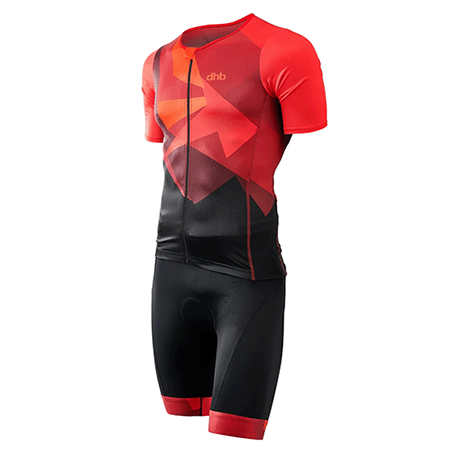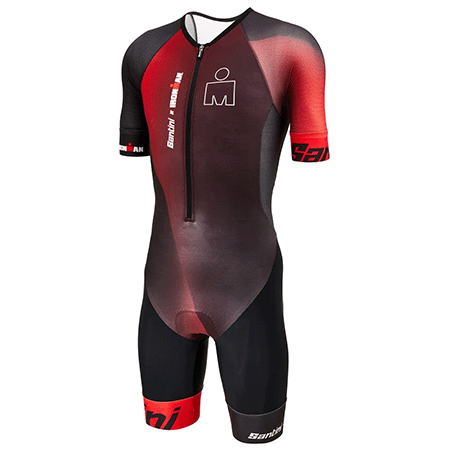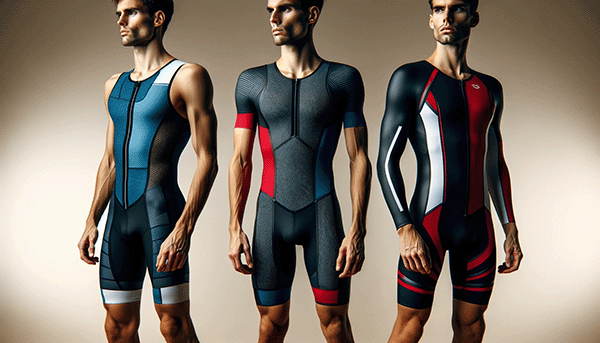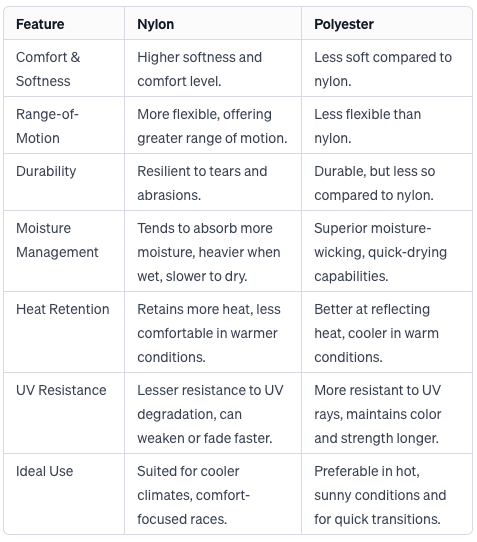Triathlon suits, often referred to as a “tri suit,” are designed specifically for the multi-discipline demands of a triathlon, which includes swimming, cycling, and running. Of course, you can simply wear running shorts and a tank top. But tri suits are intentionally designed to help triathletes during their race. They are designed to dry quickly, reduce drag, cut down on chaffing, and other benefits over using your typical running gear.
When it comes to choosing the right tri suit, there are several key considerations to keep in mind. These include choosing the right style, material and features to fit your budget.
Here’s a comprehensive guide to choosing the right tri suit for yourself. I hope it helps.
What is a Tri Suit?
A tri suit is typically worn throughout the entire triathlon race, offering solutions to common challenges in swimming, biking, and running.
For example, they are made from materials that prevent drag in the water; they are quick-drying to avoid water retention during the bike and run segments; they include padding for cycling comfort; and they are designed to minimize chafing during the run.
A tri suit is distinct from a wetsuit, as each serves different purposes. The wetsuit, worn exclusively for the swim leg, is typically made from neoprene. It is thicker, provides buoyancy, and offers thermal insulation. In contrast, tri suits do not offer buoyancy or insulation. During a race, athletes wear wetsuits over their tri suits for the swim and remove them in the first transition zone (T1).
Why Do I Need a Tri Suit?
While it may be tempting to race in your regular shorts and t-shirts, tri suits offer specific benefits that regular athletic wear does not. Unlike biking shorts, swim jammers, or running shorts, a tri suit is engineered to dry quickly and prevent water absorption in the padding, which is a common issue with biking shorts. Also, swim jammers and running shorts lack the necessary padding for cycling comfort.
Think of a tri suit as a super suit, meticulously designed for the needs of triathletes. Entry-level suits are reasonably priced and provide benefits you’ll appreciate during your race.
Let’s cover some of the major decisions you’ll need to make when selecting a tri suit…
One-Piece or Two-Piece
The first decision you’ll probably want to make is whether you want a one-piece or two piece tri suit. They each offer their own set of advantages and considerations.
As the name suggests, a one-piece is an all in one suit with a zipper. A two-piece includes separate vest and shorts.


Here are a few considerations when choosing between the two styles:
Versatility
Two-piece suits offer more flexibility in fit and sizing. So, a two piece will allow you to mix and match the vest and shorts, should you have, say, a long torso.
Likewise a two piece allows you to choose a short with padding that you like and shirt with sleeve lengths you like. With one-piece, you get the padding and sleeves that the manufacturer provides.
A two-piece suit can be more adaptable to varying temperatures. You can choose different tops and bottoms for different weather conditions, offering a practical solution to climate adaptability.
Comfort and Fit
Single-piece suits are designed to fit like a second skin, which reduces the risk of chafing and discomfort. Some suits offer extra compression, which can aid in muscle support and recovery. Two piece suits, can be more comfortable, especially during the run segment, as it allows for less restriction around the waist and stomach, providing a balance between snug fit and comfort.
Aerodynamics & Hydrodynamics
Single-piece tri suits are generally more aerodynamic, offering fewer opportunities for drag. This helps you conserve more energy. The single-piece design also reduces drag in the water. The two-piece has stitching around the waste and water can enter both piece, adding to the drag.
Convenience
During long-distance races the convenience of quickly using the restroom without removing the entire suit is a significant advantage of the two-piece suit. But this not typically a factor for sprint or olympic distance races. For this reason, many athletes prefer the single-piece for short distance races (Sprint and Olympic) and two-piece for the longer distances (half and full Ironmans).
Ultimately, the best choice between depends on your personal preference, body type, race conditions, and experience level. It’s often recommended to try both types in training to gauge which suits your style and comfort better. Remember, comfort and confidence in your gear can significantly influence your performance and enjoyment of the event.
Sleeve Options
Whether you choose a one-piece or two-piece suit, you’ll have three options of sleeve lengths — Sleeveless, Short-Sleeves or Long-Sleeves.

The choice, again, will come down to what helps you most, given your comfort, race conditions and strengths.
Sleeveless
Sleeveless tri suits give you unrestricted arm movement, which is especially beneficial during the swim leg. They’re also ideal for races in warmer conditions and help you from overheating during the bike and run. However, sleeveless suits do have downsides. They offer reduced sun protection for the shoulders and upper arms. Also, a tight-fitting sleeved tri suit can help create an aerodynamic efficiency on the bike. A sleeveless suit does not help with this.
Short-Sleeves
Short-sleeved tri suits offer a middle ground, balancing aerodynamic benefits and moderate protection against the sun. They’re versatile enough for various weather conditions, providing a mix of cooling and coverage. However, they might pose issues like potential chafing from sleeve seams and slightly restricted movement, especially for the swim leg.
Long-Sleeves
Long-sleeved tri suits help in maximizing aerodynamics, particularly advantageous during the cycling phase. They provide the best protection against sun, cold, and abrasions, and some are designed with fabrics for optimal thermal regulation. Despite these benefits, they come with their own set of cons, such as the possibility of overheating in warm conditions and reduced mobility, especially noticeable in the swim.
Again, the decision will depend on whether you prioritize range of motion, aerodynamics, or protection. The best choice depends on your individual preferences, comfort, and the specific demands of your race environment. As mentioned earlier, two piece suits allow you to quickly change tops during the transition. So if, for example, you want the arm motion range on the swim you can use a sleeveless shirt, then switch to a sleeved option to get the aerodynamic and protective benefits during the bike.
Choosing the Right Material for Your Tri Suit
Tri suits are typically made from a blend of either polyester or nylon, combined with Spandex (also known as Lycra or elastane), to create a balance of performance and comfort. The standard composition of these suits usually ranges between 20-30% spandex and 70-80% polyester or nylon, each blend offering unique benefits.
Spandex is a key component in these suits because it adds elasticity to the tri suit. This elasticity ensures a snug fit, crucial for reducing drag throughout the race. Moreover, spandex compresses the muscles, which can improve blood circulation and reduce muscle fatigue. So, suits that have higher spandex composition will give extra elasticity.
When deciding between a nylon and polyester blend for your tri suit, understanding the distinct properties of each fabric is beneficial. Both materials have their pros and cons.
Comfort and Softness
Nylon is softer than polyester and can provide a higher level of comfort throughout the race.
Range-of-Motion
Nylon’s flexibility helps give a greater range of motion over polyester. This can be a factor on the swim leg if you are choosing a sleeved suit.
Durability
Nylon is a resilient fabric, offering impressive resistance to tears and abrasions, which helps with the suit’s durability.
Moisture Management
Polyester offers better moisture-wicking than nylon and is quicker to dry. So, nylon suits may feel a little heavier during T1 and the first part of the bike leg. Keep in mind that the thickness of the material — whether nylon or polyester — will also determine how quickly a suit dries.
Weather Adaptability
Nylon retains heat more than polyester, which might make it less suitable for races in warmer climates. Polyester is also offers better UV resistance and will, therefore, not fade as much as Lyrca when used repeatedly in a sunny conditions.
So, nylon suits are generally ideal for comfort and flexibility, whereas polyester suits excel in moisture management, heat regulation, and durability. However, these are very much nuanced details. Your best route is to try a variety of suits that use different blends and fabrics to see which feels better to you.

Choosing a Color and Design
Choosing the right material for your tri suit is ultimately more important than choosing the color and design. However, it’s still an important factor. Here are a few considerations for choosing the right color and design for your tri suit.
Safety
Bright and high-contrast designs in tri suits significantly enhance visibility, a crucial factor during open-water swims where wetsuits are not used. Although high visibility swim caps are commonly provided in races, a brightly colored tri suit can further increase an athlete’s visibility.
Heat Absorption and Regulation
While the primary factor in heat regulation is the suit’s material, color also plays a role. Dark colors absorb more heat, potentially leading to discomfort in hot conditions. Conversely, light colors reflect sunlight, helping to keep athletes cooler.
Design
Different tri suits have varying cuts, with manufacturers aiming to minimize drag and chafing. Trying on a suit offers a preliminary idea of its fit, but its true effectiveness and comfort are best assessed under race conditions.
Visual Impact
Choosing the right color and design isn’t just about physical benefits; it’s also about mental confidence. This is highly personal; some athletes feel more confident being highly visible, while others prefer subtler designs. The key is selecting a suit that boosts both your physical performance and mental confidence.
